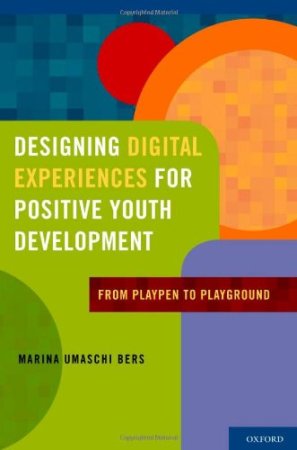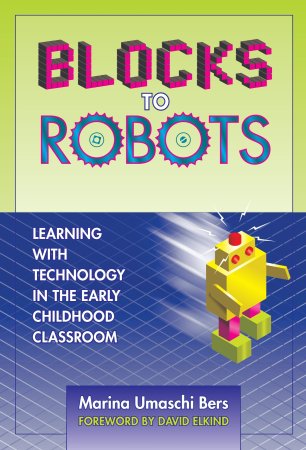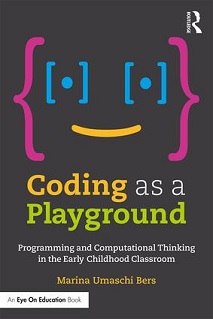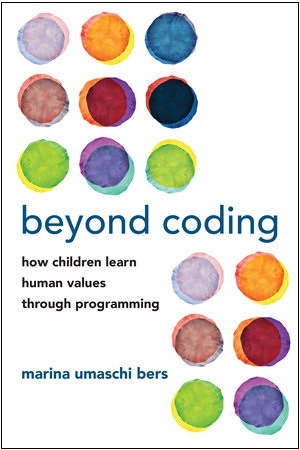Robotics Research
Early childhood STEM research…We have decades of it and are proud to offer KIBO with the backing of amazing academic and proven robotics research.
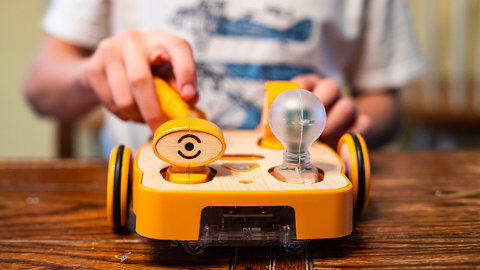
Why is it important to introduce coding robots for kids at a young age?
KIBO is the result of more than 20 years of early childhood STEM research, led by Dr. Marina Bers, a leading researcher on early childhood computer science and her research team at the DevTech Research Group. Her research shows specific, powerful, and positive learning outcomes for young learners when working with KIBO.
The greatest return on investment in educational interventions comes when those interventions are made with the youngest learners.
Early intervention is the reason why Dr. Bers and her team designed KIBO. Her robotics research shows that even the youngest students can learn sequencing and coding in a fun and engaging, hands-on way, regardless of curriculum.
From an NSF grant to Children’s Hands
 In 2013, with a dream of improving STEM education for young children with innovative and age appropriate technology based on research, Marina was awarded National Science Foundation grants. From those grants, KIBO was born.
In 2013, with a dream of improving STEM education for young children with innovative and age appropriate technology based on research, Marina was awarded National Science Foundation grants. From those grants, KIBO was born.
Powerful Learning Outcomes Using KIBO Include:
Improved Sequencing Ability in Early Childhood
PreK-Gr2 students’ performance on standard assessments of sequencing ability improved from 20-35% after an 8-week robotics and coding curriculum with KIBO.
Improved Computational Thinking with Concrete Tools
Children using KIBO performed 27% better on computational thinking than children using screen-based tools.
Counteracting Harmful Gender-Based STEM Stereotypes
After working with KIBO, 2/3 of girls expressed an interest in engineering careers – a rate equal to boys. Girls who completed a 6-week KIBO curriculum were equally as interested as boys at building and programming.
Positive Impact on Underrepresented Groups in STEM Fields
Studies demonstrate successful mastery of programming and computational thinking skills by disadvantaged students in underperforming schools.
Early Childhood STEM Research Published Aricles & Books
Evidence of KIBOs effect exists in the form of numerous published research articles and books by Marina and her team. See below for a listing of Marina’s published research.
Books By Dr. Marina Umaschi Bers
- Kourti, Z., Michalakopoulos C., Bagos, P., Paraskevopoulou-Kollia, E. (2023). Computational Thinking in Preschool Age: A Case Study in Greece. Educ. Sci, 13(2), 157.
- Weipeng Y., Davy Tsz Kit N., Jiahong S. (2023). The impact of story-inspired programming on preschool children’s computational thinking: A multi-group experiment. Thinking Skills and Creativity, Volume 47, 101218.
- Strawhacker, A., Relkin, E., & Bers, M. U. (2022). Designing an Adaptive Assessment for Preschool Children’s Robotics Knowledge. Educational Designer, 4(15), ISSN 1759-1325.
- Hassenfeld, Z. R., Govind, M., de Ruiter, L. E., & Bers, M. U. (2020). If You Can Program, You Can Write: Learning Introductory Programming Across Literacy Levels. Journal of Information Technology Education: Research, 19, 65-85. DOI: 10.28945/4509
- Hassenfeld, Z. R. & Bers, M. U. (2019). Debugging the Writing Process: Lessons From a Comparison of Students’ Coding and Writing Practices. The Reading Teacher.
- Bers, M. U. (2019). Coding as another language: a pedagogical approach for teaching computer science in early childhood. Journal of Computers in Education, 1-30.
- Bers, M. U., González-González, C., & Armas–Torres, M. B. (2019). Coding as a playground: Promoting positive learning experiences in childhood classrooms. Computers & Education, 138, 130-145.
- Albo-Canals, J., Barco Martelo, A., Relkin, E., Hannon, D., Heerink, M., Heinemann, M., Leidl, K., Bers, M.U. (2018). Pilot Study of KIBO with Children with Severe ASD. Springer Science+Business Media B.V., part of Springer Nature, 2018. Springer, Netherlands.
- Leidl, K., Bers, M.U., Mihm, C. (2017). Programming with ScratchJr: a review of the first year of user analytics. In the proceedings of the International Conference on Computational Thinking Education, 2017. Wanchai, Hong Kong.
- Sullivan, A., Bers, M.U., Mihm, C. (2017). Imagining, Playing, & Coding with KIBO: Using KIBO Robotics to Foster Computational Thinking in Young Children. In the proceedings of the International Conference on Computational Thinking Education, 2017. Wanchai, Hong Kong.
- Sullivan, A., Strawhacker, A., & Bers, M.U. (2017). Dancing, drawing, and dramatic robots: Integrating robotics and the arts to teach foundational STEAM concepts to young children. In Khine, M.S. (Eds.) Robotics in STEM Education: Redesigning the Learning Experience. Springer Publishing.
- Sullivan, A. & Bers, M.U. (2017). Computational Thinking and Young Children: Understanding the Potential of Tangible and Graphical Interfaces. In Ozcinar, H., Wong, G., & Ozturk, T. (Eds.) Teaching Computational Thinking in Primary Education. IGI Global.
- Pugnali, A., Sullivan, A., & Bers, M.U. (In press, 2017) The Impact of User Interface on Young Children’s Computational Thinking. Journal of Information Technology Education: Innovations in Practice.
- Strawhacker, A. L., Lee, M. S. C., & Bers, M. U. (2017). Teaching tools, teachers’ rules: exploring the impact of teaching styles on young children’s programming knowledge in ScratchJr. International Journal of Technology and Design Education. DOI: 10.1007/s10798-017-9400-9
- Sullivan, A., & Bers, M.U. (2017). Dancing robots: Integrating art, music, and robotics in Singapore’s early childhood centers. International Journal of Technology and Design Education. Online First. doi:10.1007/s10798-017-9397-0
- Vizner, M., & Strawhacker, A. (2016). Curious Construction Kit: A programmable building kit for early childhood. In FabLearn ’16 Proceedings of the 6th Annual Conference on Creativity and Fabrication in Education. pp. 90-93.
- Elkin, M., Sullivan, A., & Bers, M.U. (2016). Programming with the KIBO Robotics Kit in Preschool Classrooms. Computers in the Schools, 33:3, 169-186.
- Sullivan, A. & Bers, M. U. (2016). Girls, boys, and bots: Gender differences in young children’s performance on robotics and programming tasks. Journal of Information Technology Education: Innovations in Practice, 15, 145-165.
- Hilliard, L., Buckingham, M., Geldhof, G. J., Gansert, P., Stack, C., Gelgoot, E., Bers, M. U., & Lerner, R. (2016). Perspective taking and decision-making in educational game play: A mixed-methods study. Applied Developmental Science. pp. 1-13.
- Strawhacker, A., Sullivan, A., & Portsmore, M. (2016). Billund Builds Music: An Engineering Education Initiative in Danish Kindergartens. IEEE Integrated STEM Education Conference (ISEC). pp. 257-261.
- Portelance, D.J., Strawhacker, A., & Bers, M.U. (2015). Constructing the ScratchJr programming language in the early childhood classroom. International Journal of Technology and Design Education. pp. 1-16. Online First.
- Strawhacker, A. L., & Bers, M. U. (2015). “I want my robot to look for food”: Comparing children’s programming comprehension using tangible, graphical, and hybrid user interfaces. International Journal of Technology and Design Education, 25(3). pp. 293-319.
- Sullivan, A., Elkin, M., & Bers, M. U. (2015). KIBO Robot Demo: Engaging young children in programming and engineering. In Proceedings of the 14th International Conference on Interaction Design and Children (IDC ’15). ACM, Boston, MA, USA.
- Sullivan, A., & Bers, M.U. (2015). Robotics in the early childhood classroom: Learning outcomes from an 8-week robotics curriculum in pre-kindergarten through second grade. International Journal of Technology and Design Education. Online First.
- Elkin, M., Sullivan, A., & Bers, M. U. (2014). Implementing a robotics curriculum in an early childhood Montessori classroom. Journal of Information Technology Education: Innovations in Practice, 13, 153-169.
- Bers, M. U. (2014, November 6). Marina Bers: Young programmers: Think playgrounds, not playpens. Retrieved from Marina’s TedxJackson Session.
- Kazakoff, E.R. & Bers, M.U. (2014). Put your robot in, Put your robot out: Sequencing through programming robots in early childhood. Journal of Educational Computing Research, 50(4).
- Bers, M. U. (2014). Tangible kindergarten: Learning how to program robots in early childhood. In Sneider, C. I. (Ed.), The Go-To Guide for Engineering Curricula PreK-5: Choosing and using the best instructional materials for your students (pp. 133-145). Thousand Oaks, CA: Corwin.
- Strawhacker, A. L., & Bers, M. U. (2014). “I want my robot to look for food”: Comparing children’s programming comprehension using tangible, graphical, and hybrid user interfaces. International Journal of Technology and Design Education. Advance online publication. doi: 10.1007/s10798-014-9287-7
- Bers, M.U., Flannery, L.P., Kazakoff, E.R, & Sullivan, A. (2014) Computational thinking and tinkering: Exploration of an early childhood robotics curriculum, 72, 145-157.
- Bers, M.U., Seddighin, S., & Sullivan, A. (2013). Ready for robotics: Bringing together the T and E of STEM in early childhood teacher education. Journal of Technology and Teacher Education, 21(3), 355-377.
- Sullivan, A., Kazakoff, E.R., & Bers, M.U. (2013). The Wheels on the Bot Go Round and Round: Robotics Curriculum in Pre-Kindergarten. Journal of Information Technology Education: Innovations in Practice, 12, 203-219.
- Flannery, L.P. and Bers, M.U. (2013). Let’s Dance the “Robot Hokey-Pokey!”: Children’s programming approaches and achievement throughout early cognitive development.Journal of Research on Technology in Education, 46(1), 81-101.
- Bers, M.U., Matas, J. & Libman, N. (2013). Livnot U’Lehibanot, To Build and To Be Built: Making Robots in Kindergarten to Explore Jewish Identity. Diaspora, Indigenous, and Minority Education: Studies of Migration, Integration, Equity, and Cultural Survival, 7(3), 164-179.
- Bers, M.U., Seddighin, S., & Sullivan, A. (2013). Ready for robotics: Bringing together the T and E of STEM in early childhood teacher education. Journal of Technology and Teacher Education, 21(3), 355-377.
- Sullivan, A., & Bers, M. U. (2013). Gender differences in kindergarteners’ robotics and programming achievement. International Journal of Technology and Design Education, 23 (3), 691-702.
- Kazakoff, E., Sullivan, A., & Bers, M.U. (2013). The effect of a classroom-based intensive robotics and programming workshop on sequencing ability in early childhood. Early Childhood Education Journal, 41(4), 245-255. doi:10.1007/s10643-012-0554-5.
- Lee, K., Sullivan, A., Bers, M.U. (2013). Collaboration by design: Using robotics to foster social interaction in Kindergarten. Computers in the Schools, 30(3), 271-281.
- Kazakoff, E., & Bers, M. (2012). Programming in a robotics context in the kindergarten classroom: The impact on sequencing skills. Journal of Educational Multimedia and Hypermedia, 21(4), 371-391.
- Bers, M. U., & Ettinger, A. B. (2012). Programming Robots in Kindergarten to Express Identity: An Ethnographic Analysis. In B. Barker, G. Nugent, N. Grandgenett, & V. Adamchuk (Eds.), Robots in K-12 Education: A New Technology for Learning (pp. 168-184). doi:10.4018/978-1-4666-0182-6.ch008Bers, M.U. (2010). The TangibleK Robotics Program: Applied Computational Thinking for Young Children. Early Childhood Research and Practice, 12(2).



















